Abstract
This work concerns the development of a good quality graphene doped TiO2 nanotube array sensor for efficient detection of methanol. A pure and graphene doped TiO2 nanotube array was synthesized by electrochemical anodization. Morphological, structural and optical characterizations were performed to study the samples. Both the nanotube samples were produced in Au/TiO2 nanotube/Ti type MIM-structured devices. Pure and graphene-doped TiO2 nanotubes offered a response magnitude of 20% and 28% to 100 ppm of methanol at room temperature, respectively. Response/Recovery time was fast for the graphene doped TiO2 nanotube array (34 s/40 s) compared to a pure TiO2 nanotube array (116 s/576 s) at room temperature. This study confirmed the notable enhancement in methanol sensing due to the formation of local heterojunctions between graphene and TiO2 in the hybrid sample.
1. Introduction
Methanol is one of the essential organic solvents having numerous applications in the production of dyes, drugs, perfumes and colors. Moreover, it is extensively utilized in automobile fuel, wastewater denitrification and electricity generation [1]. Methanol is an extremely toxic VOC which is disastrous to human health. Repeated exposure to methanol vapors causes many problems to human beings, such as blindness, acidosis, headaches, blurred vision, shortness of breath and dizziness. Skin contact with methanol results in dermatitis or scaling and eye contact results in vision destruction [2]. With all these concerns, there is a high demand for the development of methanol sensors which are reliable, stable, and sensitive as well as able to perform at low temperatures.
Different materials like metal oxide semiconductors, polymers, carbon nanostructures, metal nanoparticles, and nanocomposites have been extensively utilized by different researchers for chemical sensing. Solid state sensors based on semiconducting metal oxides have achieved a lot in the field of chemical sensing due to their exceptional properties [3]. TiO2 is an efficient semiconducting metal oxide which can be synthesized in different nanoforms (nanotubes, nanorods, nanoparticles and nanospheres, etc.) for different applications like photocatalysis [4], chemical sensing [5], and wastewater purification [6]. In the field of vapor sensing, the 1D-TiO2 nanotube performs very well due to its ideal properties such as uniformity, stability and one dimensional electron flow [7]. Different researchers have applied different techniques such as the formation of TiO2-based hybrid to improvise the performance of TiO2-based sensors.
Two-dimensional graphene offers advanced opportunities to develop hybrids with amazing electronic catalytic behavior. The flat monolayer of graphene offers unique properties such as high surface-to-volume ratio, excessive mobility and good electrical conductivity [8]. These properties make graphene an ideal candidate to support or form hybrid with metal oxide semiconductors having high catalytic properties [9]. Some reports have been published demonstrating the sensing performance of a graphene-TiO2-based hybrid. Fan and group described the hydrothermal production of a TiO2-graphene nanocomposite and its implementation in electrochemical sensing. They showed electrochemical sensing of dopamine with excellent sensitivity and selectivity [10]. Ye and co-workers reported room temperature ammonia sensing by an rGO-TiO2 hybrid. They produced the hybrid by a simple hydrothermal method [11]. Galstyan and group reported the production of an rGO-TiO2 nanotube hybrid for hydrogen sensing. They showed the impact of GO concentration on the response of TiO2 nanotubes [12].
In this current work, a highly aligned and uniform graphene-doped TiO2 nanotube array was synthesized by way of electrochemical anodization for efficient detection of methanol vapors. A pure TiO2 nanotube array and graphene-doped TiO2 nanotube array were produced by way of electrochemical anodization. Both samples were examined and analyzed through various characterization techniques which confirmed the presence of graphene in the graphene-doped TiO2 nanotube array. Metal-insulator-metal (MIM)-structured sensors were produced by using both pure and graphene-doped TiO2 nanotubes. Graphene-doped TiO2 nanotubes showed a sensitivity of 28% with quite a fast response and recovery time of 34 s and 40 s towards 100 ppm of methanol. A pure TiO2 nanotube array, however, showed a sensitivity of 20% with relatively slow response/recovery time (116 s/576 s) in the same conditions.
2. Experimental Details
A highly ordered and oriented pure TiO2 nanotube array and graphene-doped TiO2 nanotube array were synthesized by electrochemical anodization route. Two-electrode anodic oxidation was performed for 120 min under 40 V potential where Ti foil was used as the anode and graphite was used as the cathode. The electrolyte was made up of 0.5 wt% of NH4F, 10% vol of DI water and ethylene glycol. The method to synthesize the TiO2 nanotube array was described in detail in our previous reports [13].
High purity graphene oxide suspension was used to prepare 0.2 wt% graphene oxide (GO) aqueous solution. Then an electrolyte was prepared with 0.5 wt% NH4F, 10 vol% of GO aqueous solution and ethylene glycol for the preparation of a graphene-doped TiO2 nanotube array. Again, the anodization was performed for 120 min by applying a constant voltage of 40 V. Due to the constant availability of GO in the electrolyte, graphene was doped uniformly in the TiO2 nanotubes. Both the pure TiO2 nanotube array and graphene-doped TiO2 nanotube array were annealed for 3 h at 450 °C in ambient air. Annealing made the nanotubes more robust and stable and hence more reliable to use. The flow chart describing the steps for the synthesis of pure TiO2 nanotube array and graphene doped TiO2 nanotube array is represented in Figure 1.
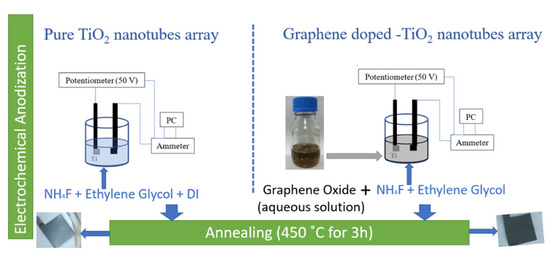
Figure 1.
Flow chart describing the synthesis procedure of pure TiO2 nanotube array and graphene-doped TiO2 nanotube array were synthesized.
The morphology of the produced samples was analysed by FESEM. The crystallographic structure of both the samples was examined via X-ray diffraction spectroscopy. Raman spectroscopy was performed for both samples which confirmed the doping of graphene in graphene-doped TiO2 nanotube array (GO-TiO2).
To produce the MIM structure for the sensors, Au was deposited on top of TiO2 nanotube/Ti and GO-TiO2 nanotube/Ti samples by electron beam evaporation.. 100 nm thick deposited Au was considered as the top electrode and Ti was considered as the bottom electrode. Both samples were enveloped in Cu mask to ensure 1*1mm2 Au top electrode. A part from the corner of the TiO2 nanotubes was etched with hydro fluoric acid to induce Ti as the bottom electrode.
The produced sensors were tested against the methanol vapours. The sensors were examined at room temperature. The sensor setup with their properties has been discussed previously [14]. Resistance in the ambient air (Ra) and in the exposure of the reducing vapours (Rg), methanol was observed. The response magnitude is calculated as [(Ra − Rg)/Ra] * 100. The response time and recovery time for both sensors is defined as 90% of maximum change of the resistance when exposed to methanol vapours and exposed to synthetic air for the removal of vapors, respectively.
3. Results and Discussion
3.1. Material Characterization
FESEM confirmed the formation of highly ordered and uniform nanotubes in both the samples (Figure 2). Highly aligned nanotubes were formed with an approximate average outer diameter of 110 nm and length of 1 µm in both the pure TiO2 nanotube array and graphene doped TiO2 nanotube array. Graphene does not hamper the original morphology of TiO2 nanotubes (Figure 2c,d). As graphene was uniformly doped inside the nanotubes, it was hard to observe the graphene with scanning electron microscopy. The chemical composition was studied through the EDS spectra, where the evidence of carbon is clearly visible in a GO-doped TiO2 nanotube array (Figure 2f).
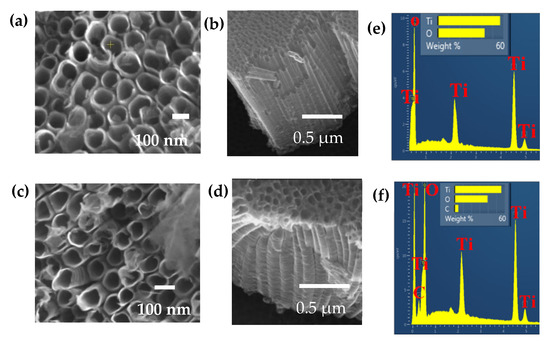
Figure 2.
FESEM Image of Pure TiO2 nanotube array (a) Top view, (b) Side view (e) EDS spectra and Graphene-doped TiO2 nanotube array (c) Top view, (d) Side view (f) EDS spectra.
The sharp intensity peak at 25.3° in both the samples is attributed to the anatase crystallinity of TiO2 nanotubes (Figure 3a). A low intensity peak at 52° corresponds to the anatase crystallinity A (105) in both the samples. A small peak at 54.1°, present only in the pure TiO2 nanotube array, corresponds to A (201) and clearly shows the presence of more anatase in the pure TiO2 nanotube array. The peaks labelled as T arise due to the use of a Titanium substrate in both the samples. T peak intensity is high in the pure TiO2 nanotube array and less in the graphene-doped TiO2 nanotube array in comparison to the A (101) peak.
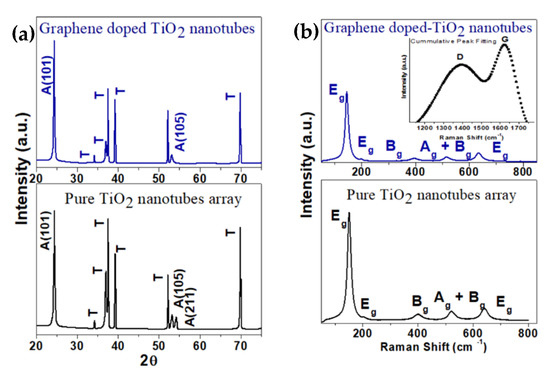
Figure 3.
Pure TiO2 nanotube array and Graphene doped TiO2 nanotube array (a) XRD Spectra, (b) Raman spectra.
The Raman spectra of pure TiO2 nanotube array and graphene-doped TiO2 nanotube array is represented in Figure 3b. The presence of pure anatase is determined by six active modes Eg (144 cm−1), Eg(197 cm−1), Bg (399 cm−1) Ag + Bg (516 cm−1) and Eg (639 cm−1) present in both the samples [13]. The sharp intensity peak at 144 cm-1 determines the formation of Ti-O in the anatase phase of TiO2. The presence of graphene is authenticated by the sharp peaks at 1348 cm−1 (D band) and 1596 cm−1 (G band) in the graphene-doped TiO2 nanotube array [15]. The active modes of the anatase TiO2 nanotube and graphene were present at their corresponding positions even after the uniform doping of graphene.
3.2. Methanol Sensing
The two MIM-structure based sensors were examined against the reducing vapours, methanol, at room temperature. The resistance of the pure TiO2 nanotube array and graphene-doped TiO2 nanotube array was 90 MΩ and 30 MΩ, respectively. The reduced resistance (increased conductance) of graphene-doped TiO2 nanotube array sensor clearly defines the incorporation of graphene inside a TiO2 nanotube. Both the sensors were subjected to 100 ppm of methanol at room temperature. The response magnitude of pure the TiO2 nanotube array and graphene-doped TiO2 nanotube array was 20% and 28%, respectively. The pure TiO2 nanotube array had a response time and recovery time of 116 s and 576 s, respectively. Moreover, there was the improvement in response time (34 s) and recovery time (40 s) in the case of the graphene-doped TiO2 nanotube array (Figure 4a).
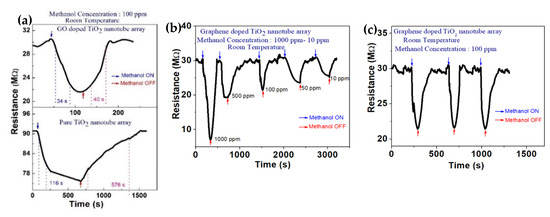
Figure 4.
(a)Transient behavior of pure TiO2 nanotube array sensor and graphene-doped TiO2 nanotube array sensor in 100 ppm methanol at RT with measured response time and recovery time; Graphene-doped TiO2 nanotube array sensor; (b) Transient behavior from methanol concentration range of: −1000 ppm to 10 ppm; (c) Repeated cycles in 100 ppm methanol at RT.
A transient was measured within a concentration range of 1000 ppm to 10 ppm for a graphene-doped TiO2 nanotube array sensor (Figure 4b). A good response magnitude was obtained in 1000 ppm methanol (77.7%) and an average response magnitude was obtained in 10 ppm methanol (19%) at room temperature. The graphene-doped TiO2 nanotube array sensor exhibited a stable baseline resistance with highly repeatable transient behavior at room temperature (Figure 4c). The graphene-doped TiO2 nanotube array sensor response was improvised with short response time and recovery time due to the incorporation of graphene inside TiO2 nanotubes.
3.3. Methanol Sensing Mechanism
The large surface area and two dimensional structure of graphene enhanced the sensing performance of graphene-doped TiO2 nanotube array sensor. This increased conductance of graphene doped TiO2 nanotube array sensor can be attributed to the large carrier mobility and high electrical conductance of graphene. The uniform doping of graphene inside the TiO2 nanotubes improved the sensing parameters of graphene-doped TiO2 nanotube array and enabled room temperature sensing.
An energy band diagram of both junctions was sketched by considering the work function of GO [16] and anatase n-TiO2 [17]. An energy band gap of 3.59 eV for pure GO and 3.2 eV for pure TiO2 (S0) were estimated from a literature survey. On the formation of a heterojunction between TiO2 and GO, electrons are transferred to TiO2 and get accumulated on the TiO2 surface.
Surface adsorption of oxygen groups (O2−, O−, O2−) reduces the electron concentration (Equations (1)–(3)) and increases the width of the depletion region, resulting in the formation of built-in potential on the surface of the graphene-doped TiO2 nanotube array sensor as represented in Figure 5. Upon exposure to the methanol vapors, the trapped electron oxygen groups are released back to the surface of the graphene-doped TiO2 nanotube array sensor, lowering the built-in potential.
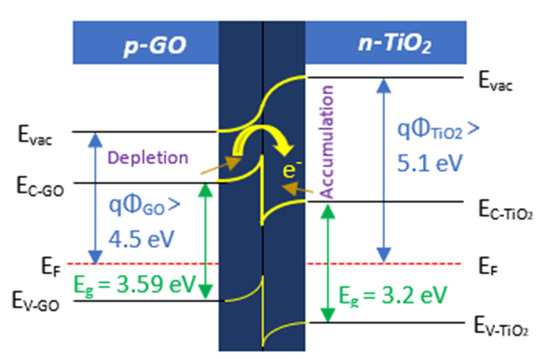
Figure 5.
Heterojunction formed between p-type GO and n-TiO2 nanotubes with electron depletion in GO and electron accumulation in TiO2.
When methanol vapor react with the oxygen species it gets oxidised into formaldehyde, then to formic acid and then it releases electrons to the conduction band which, in turn, reduces the resistance of the sensor in exposure to methanol vapors (Equations (4) and (5)) [18].
Formation of depletion region across the TiO2 and GO junction plays an important role for improving the sensor response. Uniform doping of graphene on the TiO2 surface is the main reason for enhancing the change of current in-between air and VOC ambient that eventually shows high sensitivity towards methanol by the graphene doped TiO2 nanotube sensor at room temperature with quick response time and recovery time.
4. Conclusions
In this work, electrochemical anodization was applied to develop pure TiO2 nanotube array and graphene-doped TiO2 nanotube array. Graphene was doped in the TiO2 nanotubes without hampering the original morphology of the nanotubes. Morphological characterization confirmed the formation of highly aligned and uniform nanotubes and structural characterization confirmed the anatase crystallinity of TiO2 nanotubes in both the samples. The evidence of graphene in the hybrid nanotubes was authenticated by the D and G peaks in the Raman spectra. The pure and graphene-doped TiO2 nanotube array sensor was produced in MIM structure where Au was considered as the top electrode and Ti was considered as the bottom electrode. Pure TiO2 nanotube array showed a response magnitude of 20% with slow response time (116 s) and recovery time (576 s) to 100 ppm methanol at room temperature. Graphene-doped TiO2 nanotube array showed a better response magnitude of 28% with a quick response time (34 s) and recovery time (40 s) to 100 ppm of methanol at room temperature. Also, lower detection limit till 10 ppm with good response magnitude (19%) towards methanol was achieved with the graphene-doped TiO2 nanotube array sensor at room temperature. A significant improvement in methanol sensing was achieved by the formation of localized heterojunctions between graphene and TiO2 in the hybrid sample.
Supplementary Materials
The following are available online at https://www.mdpi.com/article/10.3390/CSAC2021-10620/s1.
Author Contributions
Experiment, analysis and writing by T.G.; A.H. designed the research. Review editing and validation was also done by A.H. All authors have read and agreed to the published version of the manuscript.
Funding
This work was supported in part by Department of Biotechnology grant (Letter No. BT/PR28727/NNT/28/1569/ 2018), SPARC grant (SPARC/2018-2019/P1394/SL), and CSIR-SRF Direct (1431120/2k19/1) fellowship Govt. of India.
Institutional Review Board Statement
The study was conducted according to the guidelines and Deceleration of BITS Pilani.
Informed Consent Statement
Not applicable.
Data Availability Statement
Not applicable.
Conflicts of Interest
There are no conflicts to declare.
References
- Bindra, P.; Hazra, A. Impedance behavior of n-type TiO2 nanotubes porous layer in reducing vapor ambient. Vacuum 2018, 152, 78–83. [Google Scholar] [CrossRef]
- Mirzaei, A.; Leonardi, S.G.; Neri, G. Detection of hazardous volatile organic compounds (VOCs) by metal oxide nanostructures-based gas sensors: A review. Ceram. Int. 2016, 42, 15119–15141. [Google Scholar] [CrossRef]
- Bindra, P.; Gangopadhyay, S.; Hazra, A. Au/TiO2 Nanotubes/Ti-based solid-state vapor sensor: Efficient sensing in resistive and capacitive modes. IEEE Trans. Electron. Devices 2018, 65, 1918–1924. [Google Scholar] [CrossRef]
- Zhang, J.; Xu, Q.; Feng, Z.; Li, M.; Li, C. Importance of the relationship between surface phases and photocatalytic activity of TiO2. Angew. Chem. 2008, 120, 1790–1793. [Google Scholar] [CrossRef]
- Liu, Y.; Li, J.; Qiu, X.; Burda, C. Novel TiO2 nanocatalysts for wastewater purification: Tapping energy from the sun. Water Sci. Technol. 2006, 54, 47–54. [Google Scholar] [CrossRef] [PubMed]
- Hazra, A.; Bhowmik, B.; Dutta, K.; Chattopadhyay, P.P.; Bhattacharyya, P. Stoichiometry, length, and wall thickness optimization of TiO2 nanotube array for efficient alcohol sensing. ACS Appl. Mater. Interfaces 2015, 7, 9336–9348. [Google Scholar] [CrossRef] [PubMed]
- Hazra, A.; Bhattacharyya, P. Tailoring of the gas sensing performance of TiO2 nanotubes by 1-D vertical electron transport technique. IEEE Trans. Electron. Devices 2014, 61, 3483–3489. [Google Scholar] [CrossRef]
- Geim, A.K.; Novoselov, K.S. The Rise of Graphene; Manchester Centre for Mesoscience and Nanotechnology, University of Manchester: Manchester, UK, 2009. [Google Scholar]
- Williams, G.; Seger, B.; Kamat, P.V. TiO2-graphene nanocomposites. UV-assisted photocatalytic reduction of graphene oxide. ACS Nano 2008, 2, 1487–1491. [Google Scholar] [CrossRef] [PubMed]
- Fan, Y.; Lu, H.T.; Liu, J.H.; Yang, C.P.; Jing, Q.S.; Zhang, Y.X.; Yang, X.K.; Huang, K.J. Hydrothermal preparation and electrochemical sensing properties of TiO2–graphene nanocomposite. Colloids Surf. B Biointerfaces 2011, 83, 78–82. [Google Scholar] [CrossRef] [PubMed]
- Ye, Z.; Tai, H.; Guo, R.; Yuan, Z.; Liu, C.; Su, Y.; Chen, Z.; Jiang, Y. Excellent ammonia sensing performance of gas sensor based on graphene/titanium dioxide hybrid with improved morphology. Appl. Surf. Sci. 2017, 419, 84–90. [Google Scholar] [CrossRef]
- Galstyan, V.; Ponzoni, A.; Kholmanov, I.; Natile, M.M.; Comini, E.; Nematov, S.; Sberveglieri, G. Reduced graphene oxide–TiO2 nanotube composite: Comprehensive study for gas-sensing applications. ACS Appl. Nano Mater. 2018, 1, 7098–7105. [Google Scholar] [CrossRef]
- Gakhar, T.; Hazra, A. Oxygen vacancy modulation of titania nanotubes by cathodic polarization and chemical reduction routes for efficient detection of volatile organic compounds. Nanoscale 2020, 12, 9082–9093. [Google Scholar] [CrossRef] [PubMed]
- Bindra, P.; Hazra, A. Selective detection of organic vapors using TiO2 nanotubes based single sensor at room temperature. Sens. Actuators B Chem. 2019, 290, 684–690. [Google Scholar] [CrossRef]
- Malard, L.M.; Pimenta, M.A.; Dresselhaus, G.; Dresselhaus, M.S. Raman spectroscopy in graphene. Phys. Rep. 2009, 473, 51–87. [Google Scholar] [CrossRef]
- Singhal, A.V.; Charaya, H.; Lahiri, I. General synthesis of graphene-supported bicomponent metal monoxides as alternative high-performance Li-ion anodes to binary spinel oxides. Crit. Rev. Solid State Mater. Sci. 2017, 42, 1–28. [Google Scholar]
- Scanlon, D.O.; Dunnill, C.W.; Buckeridge, J.; Shevlin, S.A.; Logsdail, A.J.; Woodley, S.M.; Catlow, C.R.A.; Powell, M.J.; Palgrave, R.G.; Parkin, I.P.; et al. Band alignment of rutile and anatase TiO2. Nat. Mater. 2013, 12, 789. [Google Scholar] [CrossRef] [PubMed]
- Sahay, P.P.; Nath, R.K. Al-doped ZnO thin films as methanol sensors. Sens. Actuators B Chem. 2008, 134, 654–659. [Google Scholar] [CrossRef]
Publisher’s Note: MDPI stays neutral with regard to jurisdictional claims in published maps and institutional affiliations. |
© 2021 by the authors. Licensee MDPI, Basel, Switzerland. This article is an open access article distributed under the terms and conditions of the Creative Commons Attribution (CC BY) license (https://creativecommons.org/licenses/by/4.0/).